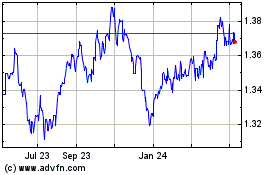Commodity Currencies Fall As Asian Shares Traded Lower
June 19 2023 - 10:38PM
RTTF2
Commodity currencies such as the Australia, the New Zealand and
the Canadian dollars weakened against their major currencies in the
Asian session on Tuesday, as investors remained cautious after
China's central bank did not introduce further stimulus as
speculated to prop up its flagging economic recovery. Meanwhile,
the central bank cut some of its key lending rates for the first
time in 10 months.
Traders also looked ahead to US Fed Chair Jerome Powell's
congressional testimonies on Wednesday and Thursday for clues on
the monetary policy ahead. They also looked ahead to the Bank of
England's monetary policy later in the week.
Meanwhile, the Australian dollar fell further after the minutes
of the RBA's June board meeting in the early Asian session.
At the meeting, board members said that the decision to hike
interest rate in June was 'finely balanced'. Thus, traders'
expectation of further rate hike eased.
Also, the minutes signaled that further rate hike would develop
uncertainty regarding the outlook for household spending and
inflation.
In the Asian trading today, the Australian dollar fell to nearly
a 2-week low of 1.6062 against the euro and a 4-day low of 96.30
against the yen, from yesterday's closing quotes of 1.5939 and
97.26, respectively. If the aussie extends its downtrend, it is
likely to find support around 1.64 against the euro and 93.00
against the yen.
Against the U.S. and the Canadian dollars, the aussie dropped to
a 5-day low of 0.6798 and an 8-day low of 0.8989 from Monday's
closing quotes of 0.6849 and 0.9047, respectively. The aussie may
test support near 0.66 against the greenback and 0.87 against the
loonie.
The aussie slid to a 5-day low of 1.0991 against the NZ dollar,
from an early 4-month high of 1.1053. On the downside, 1.08 is seen
as the next support level for the aussie.
The NZ dollar fell to a 5-day low of 0.6171 against the U.S.
dollar and a 4-day low of 87.54 against the yen, from yesterday's
closing quotes of 0.6199 and 88.04, respectively. If the kiwi
extends its downtrend, it is likely to find support around 0.60
against the greenback and 84.00 against the yen.
Against the euro, the kiwi dropped to nearly a 2-week low of
1.7688 from Monday's closing value of 1.7603. The next downside
target level for the kiwi is seen around the 1.79 area.
The Canadian dollar fell to a 4-day low of 1.3232 against the
U.S. dollar, from yesterday's closing value of 1.3208. If the
loonie extends its downtrend, it is likely to find support around
the 1.34 area.
The loonie edged down to 1.4442 against the euro, from Monday's
closing value of 1.4422. On the downside, 1.46 is seen as the next
support level for the loonie.
Moving away from near 7-1/2 month high of 107.67 against the
yen, the loonie slipped to 107.07. The loonie may find support
around the 102.00 area.
Meanwhile, the safe-haven yen rose against its major rivals, as
Asian shares traded lower.
The yen rose to 4-day highs of 154.59 against the euro and
181.15 against the pound, from yesterday's closing quotes of 155.02
and 181.48, respectively. If the yen extends its uptrend, it is
likely to find resistance around 149.00 against the euro and 174.00
against the pound.
Against the U.S. dollar, the yen advanced to 141.58 from an
early 7-month low of 142.25. On the upside, 138.00 is seen as the
next resistance level for the yen.
The yen edged up to 157.98 against the Swiss franc, from
yesterday's closing value of 158.41. The yen may test resistance
around the 153.00 area.
Looking ahead, Eurozone current account data for April and
construction output for April are due to be released in the
European session.
In the New York session, U.S. building permits and housing
starts for May are slated for release.
US Dollar vs CAD (FX:USDCAD)
Forex Chart
From Jun 2024 to Jul 2024

US Dollar vs CAD (FX:USDCAD)
Forex Chart
From Jul 2023 to Jul 2024
